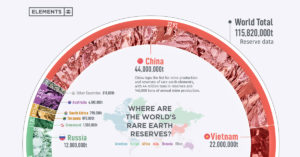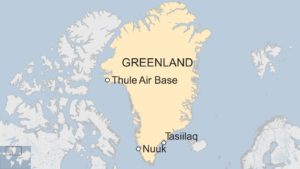by Mining.com Staff Writer, Jan 28, 2022, in TheNorthernMinerMaps
In a paper published in the journal Geology, the scientists explain that over geological times, variations in atmospheric CO2 depended mainly on volcanic emissions, which are difficult to estimate because they are not directly related to the volume of the magmas that erupted. Indeed, some volcanoes show exceptionally large emissions of CO2 when compared to the amount that can be dissolved in their magmas. Etna is perhaps the most striking example, contributing to 10% (9000 tons/day) of the present global volcanic CO2 emission. That is three times more CO2 than a volcano like Kilauea in Hawaii emits, which erupts four times more magma.
But ratios of Nb/Ta are very constant in many rocks and are only modified by few geological processes—like the infiltration of carbonate-rich melts in earth’s mantle.
…
by N. Le Pan, Nov 22, 2021 in Elements

…
by P. Homewood, Nov 10, 2021 in NotaLotofPeopleKnowThat
Minerals are essential components in many of today’s rapidly growing clean energy technologies – from wind turbines and electricity networks to electric vehicles. Demand for these minerals will grow quickly as clean energy transitions gather pace. This new World Energy Outlook Special Report provides the most comprehensive analysis to date of the complex links between these minerals and the prospects for a secure, rapid transformation of the energy sector.
Alongside a wealth of detail on mineral demand prospects under different technology and policy assumptions, it examines whether today’s mineral investments can meet the needs of a swiftly changing energy sector. It considers the task ahead to promote responsible and sustainable development of mineral resources, and offers vital insights for policy makers, including six key IEA recommendations for a new, comprehensive approach to mineral security.
https://www.iea.org/reports/the-role-of-critical-minerals-in-clean-energy-transitions
The salient points follow:

…
by L. Peter, Nov 2019 in BBCNews
Denmark has for the first time put mineral-rich Greenland top of its national security agenda, ahead of terrorism and cybercrime.
The Defence Intelligence Service (FE) linked its change in priorities to US interest in Greenland, expressed in President Donald Trump’s desire to buy the vast Arctic territory.

Greenland is part of Denmark, but has significant autonomy, including freedom to sign major business deals.
China has mining deals with Greenland.
The FE’s head Lars Findsen said Greenland was now a top security issue for Denmark because a “power game is unfolding” between the US and other global powers in the Arctic.
In August the Danish government dismissed as “absurd” President Trump’s suggestion of a US-Denmark land deal over Greenland.
The US interest in Greenland goes back decades. The US has a key Cold War-era air base at Thule, used for surveillance of space using a massive radar. It is the US military’s northernmost base, there to provide early warning of a missile attack on North America.
Why the new focus on Greenland?
Greenland’s strategic importance has grown amid increased Arctic shipping and international competition for rare minerals. Arctic waters are becoming more navigable because of melting ice, linked to global warming.
…
by P. Homewood, Jan 6, 2021 in NotaLotofPeopleKnowThat
When Donald Trump offered to buy Greenland from Denmark in 2019 it was dismissed as illegal and absurd. However, the president’s expression of interest was far from absurd, says Guillaume Pitron. Under its soil Greenland boasts one of the largest concentrations of the rare metals that the world will need to power electric cars, computers, mobile phones, robots, solar power plants, artificial intelligence and many high-tech “green” innovations that have not been dreamt up yet. If Trump were after those minerals, buying Greenland would have been a smart move.
The global production and sales of rare metals are dominated by China. It mines so much of them on home soil and controls so much of their extraction in Africa and elsewhere that it oversees up to 95 per cent of the global production of certain minerals. This puts Beijing in charge of “the oil of the 21st century”, writes Pitron, which is a problem for western nations because it means China can restrict supply and drive prices up or down at will, as Opec does with oil. We have “entrusted a precious monopoly of mineral sovereignty to potential rivals”, he notes.

Discarded devices waiting to have their precious metals extracted
CHARLY TRIBALLEAU/GETTY IMAGES
Rare earth minerals production is very energy intensive. Extracting a single kilogram of some requires mining as much as 1,200 tonnes of rock. “Clean energy is a dirty affair,” Pitron writes. He drives home his point by touring villages near polluted lakes in China that are known locally as “cancer villages”.
…
by University of Exter, Oct. 11, 2020 in WUWT
Pioneering new research has helped geologists solve a long-standing puzzle that could help pinpoint new, untapped concentrations of some the most valuable rare earth deposits.
A team of geologists, led by Professor Frances Wall from the Camborne School of Mines, have discovered a new hypothesis to predict where rare earth elements neodymium and dysprosium could be found.
The elements are among the most sought after, because they are an essential part of digital and clean energy manufacturing, including magnets in large wind turbines and electric cars motors.
For the new research, scientists conducted a series of experiments that showed sodium and potassium – rather than chlorine or fluorine as previously thought – were the key ingredients for making these rare earth elements soluble.
This is crucial as it determines whether they crystalise – making them fit for extraction – or stayed dissolved in fluids.
The experiments could therefore allow geologists to make better predictions about where the best concentrations of neodymium and dysprosium are likely to be found.
The results are published in the journal, Science Advances on Friday, October 9th 2020.
University of Exeter researchers, through the ‘SoS RARE’ project, have previously studied many natural examples of the roots of very unusual extinct carbonatite volcanoes, where the world’s best rare earth deposits occur, in order to try and identify potential deposits of the rare earth minerals.
…
…
by Geological Society of America, January 13, 2020 in ScienceDaily
Rare metallic elements found in clumps on the deep-ocean floor mysteriously remain uncovered despite the shifting sands and sediment many leagues under the sea. Scientists now think they know why, and it could have important implications for mining these metals while preserving the strange fauna at the bottom of the ocean.
The growth of these deep-sea nodules — metallic lumps of manganese, iron, and other metals found in all the major ocean basins — is one of the slowest known geological processes. These ringed concretions, which are potential sources of rare-earth and other critical elements, grow on average just 10 to 20 millimeters every million years. Yet in one of earth science’s most enduring mysteries, they somehow manage to avoid being buried by sediment despite their locations in areas where clay accumulates at least 100 times faster than the nodules grow.
Understanding how these agglomerations of metals remain on the open sea floor could help geoscientists provide advice on accessing them for industrial use. A new study published this month in Geology will help scientists understand this process better.
“It is important that any mining of these resources is done in a way that preserves the fragile deep-sea environments in which they are found,” said lead author Adriana Dutkiewicz, an ARC Future Fellow in the School of Geosciences at The University of Sydney.
Rare-earth and other critical elements are essential for the development of technologies needed for low-carbon economies. They will play an increasingly important role for next-generation solar cells, efficient wind turbines, and rechargeable batteries that will power the renewables revolution.
…
by Geological Society of America, January 2, 2020 in ScienceDaily
Scientists from the U.S. Geological Survey (USGS) have mapped a rare earth element deposit of magmatic carbonatite located in the Mountain Pass region of the eastern Mojave Desert. The new report details the geophysical and geological setting of the deposit, including a map of the deposit’s subsurface extent, to help land-use managers evaluate sites for further exploration. The report was recently published in the Geological Society of America’s online journal, Geosphere.
Rare earth elements (REEs) are critical to emerging industrial technologies including strategic defense, science and medical, automotive and transportation, and civilian electronics. However, large economic REE sources are unique and uncommon worldwide. International concerns about increasing demand and global supply vulnerability have prompted many countries, including the U.S., to explore and assess domestic REE resources. Increased efforts to characterize geologic processes related to REE deposits in the U.S. have focused attention on the world-class Mountain Pass, California, deposit located approximately 60 miles southwest of Las Vegas, Nevada.
In their study, collaborators K.M. Denton and USGS colleagues use geophysical and geological techniques to image geologic structures related to REE mineral-bearing rocks at depth. Their work suggests REE minerals occur along a fault zone or geologic contact near the eastern edge of the Mescal Range. These findings could prove as a useful guide to future exploration efforts.
La géologie, une science plus que passionnante … et diverse




